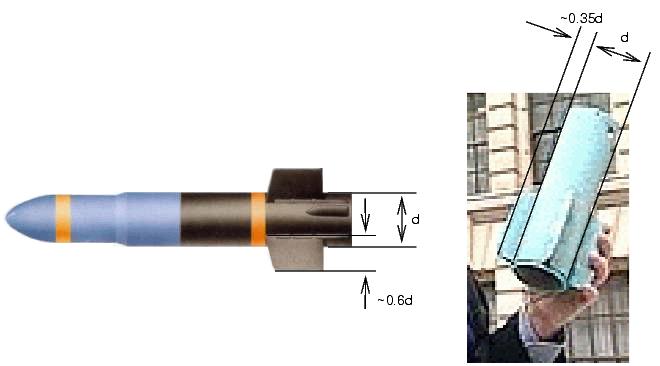This is a peculiar story. It turns out that the Ministry of Defence has more Swingfire missiles than it knows what to do with, and is disposing of them. (I think they're obsolete, or something.) Now, like those batteries which say on the side that you must dispose of them carefully and not just leave them in the wheelie bin for the local council to collect, anti-tank missiles can't just be chucked in the landfill. (Unlike batteries, Swingfire missiles contain a 7kg warhead and so the instruction `do not dispose of in fire' is to be taken seriously.)
Apparently what the Ministry of Defence (or, rather, their contractor QinetiQ, who used to be DERA) actually do is to take their spare missiles down to the beach, wait for the tide to come in, and then blow them up. Really.
The last time they tried this, they didn't tie the missiles down properly, and twenty of them supposedly floated off down the Bristol Channel. (The Swingfire missile is about a meter long and 17cm in diameter. It weighs 27kg, and so on the face of it the missile should be slightly too dense to float. It's possible that some heavy component is removed from the things before they're disposed of.) The contractors did, helpfully, inform the Ministry of Defence that the missiles had been lost, but only 14 hours after they drifted off (presumably during that time the QinetiQ people were trying to think of a plausible `dog-ate-my-homework' style excuse to explain what they'd done).
The local MP, Ian Liddell-Grainger, is apparently (and quite reasonably) upset that 140kg of high explosives is bobbing about off the coast of his constituency, ready to wash ashore and blow some unlucky voter into bite-sized chunks, should they be strolling along the foreshore at the wrong moment. (The Ministry of Defence assures us that the missiles aren't armed and can't go off. And as we know, all electronic equipment carries on working exactly as designed after being dunked in salt water for several months.)
Mr. Liddell-Grainger (who is a Major in the Territorial Army) decided to take matters into his own hands, and wandered down to Kilve, five miles west of Hinkley Point nuclear power station, where he found some fragments of missile. Donning his flak jacket, he then returned them to the Ministry of Defence, earning something of a rocket for `endangering the public' by doing so. (Though, as we have learned, the missiles were completely safe. Hmm....)
Stranger and stranger, the BBC now tells us -- based on information from a chap called Jim O'Halloran from Janes Defence -- that these missiles aren't the missing Swingfires, on the basis that they're too small and the fins are the wrong shape. Which seems plausible: the Swingfire has a diameter of 17cm, and unless Mr. Liddell-Grainger has very large hands, it's not likely that he could hold one like this: (picture adapted from this story at the BBC)

-- he seems to have got all 17cm of the missile between his thumb and forefinger, which is a bit implausible. (17cm is about ¾ of the short side of a piece of A4 paper. So if you crease a piece of A4 down the middle, then fold a quarter of it over, you can see what size the missile is.)
Further, the missile he's holding has fins whose length is about 35% the diameter of the missile; the Swingfire's fins are about 85% of the diameter of the missile:

(The 85% is obtained by multiplying the 60% shown above by sqrt(2) to account for the oblique aspect of the fin shown.)
So Mr. Liddell-Grainger has, apparently, found a completely different kind of missile washed up on the beach. The Bristol Channel must be swimming with the damned things. Forget North Korea, now is the time to disarm the Irish Sea!
(I have to say that, when as a child I went on holiday to the seaside, I didn't find any anti-tank munitions lying in the surf. I feel rather cheated. They would have brightened up many a dull seaside day.)
More seriously, I'd love to know how QinetiQ came up with its scheme for disposing of obsolete weapons. Wouldn't it be safer just to flog them to some third-world dictator? Of course, dumping obsolete weapons at sea is something of a tradition here, with old phosphorus incendiary bombs and other such junk regularly washing ashore on the Isle of Man and in Cumbria and Scotland, occasionally causing injuries. The Government don't even know how much stuff was dumped in Beaufort's Dyke (the deepest part of the Irish Sea), though there's at least 14,500 tonnes of phosgene shells down there.
(Actually, disposing of chemical weapons at sea probably was the sensible thing to do, though it was done in a fairly haphazard manner and in bad weather the ships carrying the stuff often tossed it over the side just out of harbour, which does not inspire confidence. No doubt disposing of the munitions in the deep ocean -- rather than coastal waters -- would have been more expensive, but with hindsight the additional cost sounds reasonable.)
But in the case of conventional weapons, surely they could just have buried them and then set them off, which sounds like it has less potential for cock-ups. Or dismantled them. Anything other than leaving them on the beach and having them wash away....